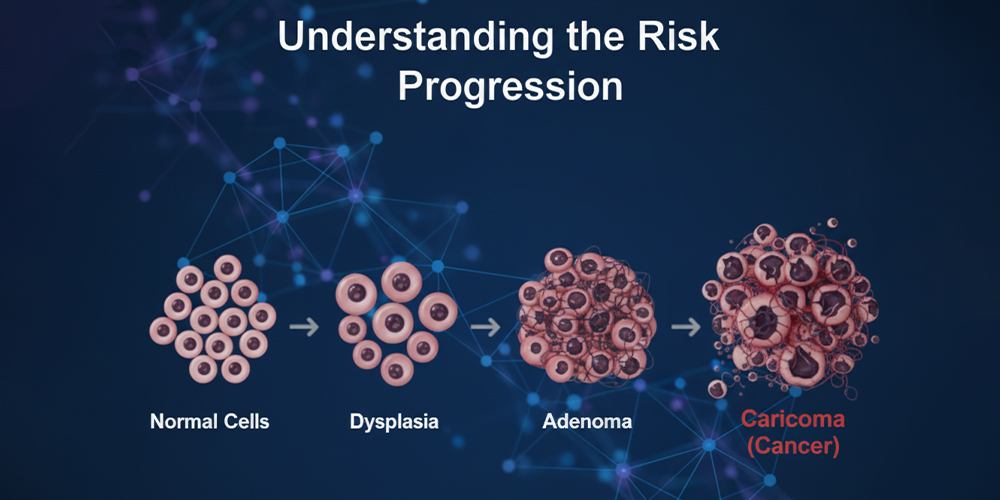
Key Takeaways:
- Is Tubular Adenoma Cancer? No, but it’s a precancerous growth that can develop into cancer if untreated.
- The risk increases with larger size, multiple growths, or high-grade dysplasia.
- Early detection and removal during colonoscopy prevent most cases from progressing to colorectal cancer.
- Dysplasia indicates abnormal cells; low grade is mild, while high grade signals serious risk.
- Clinical research and oncology trials improve prevention, diagnosis, and treatment for tubular adenomas.
- Maintaining a healthy lifestyle and regular screenings greatly reduces future cancer risk.
Introduction
Tubular adenomas are small growths detected inside the colon during colonoscopy. Their presence serves as a warning sign for colorectal cancer. Fortunately, fewer than 10% of these polyps progress to cancer.
It is important to know what tubular adenomas are, how they form, and their link to cancer. This article examines these topics, clarifying the risks associated with the condition and how current clinical research is advancing its diagnosis and treatment.
What is a Tubular Adenoma?
A Tubular Adenoma is a type of polyp found in the lining of the colon or rectum. Polyps are small clumps of cells that form on the inner wall of the colon, and while most are benign, some can become cancerous over time. So, is Tubular Adenoma cancer?
The short answer is no; a tubular adenoma of colon is not cancer, but it has the potential to develop into one if left untreated.
These adenomas are considered precancerous lesions, meaning they contain abnormal cells that could eventually turn malignant. They typically grow slowly and can remain noncancerous for years. However, the risk of cancer increases when the adenoma grows larger or develops certain cellular abnormalities.
How Do Tubular Adenoma Polyps Form?
Some changes in your body cause an abnormal proliferation of the cells, called a mutation. Some of these abnormal growth leads to the development of polyps and other types of tumors. You can distinguish adenomas by looking at their size and anatomy; usually, they grow in sizes less than 1/2 inches.
The exact reason for adenomas is unknown; however, experts have been able to identify the risk factors, such as genetics and environmental factors.
Certain colon polyps form as a result of long-term inflammation, often linked to conditions like ulcerative colitis or Crohn’s disease. Although inflammation-related polyps themselves rarely become cancerous, these inflammatory bowel diseases still heighten the risk of colon cancer. The chronic inflammation they cause damages the colon lining, and as the body continuously works to repair this damage, the increased cell turnover raises the chances of cancer development.
Dysplasia and Its Role in Tubular Adenomas
To understand the cancer risk, you need to know about dysplasia, the term used to describe abnormal cellular changes in adenoma. Dysplasia indicates that the cells within the polyp are not normal but not yet cancerous.
Dysplasia is classified into two categories:
Tubular Adenoma with Low Grade Dysplasia
Tubular Adenoma with Low Grade Dysplasia is the most common form and suggests that only minor abnormalities are present. The risk of cancer is relatively low at this stage, but continuous monitoring is crucial.
Tubular Adenoma with High Grade Dysplasia
Tubular Adenoma with High Grade Dysplasia indicates more significant cellular abnormalities and a much higher chance of turning into colorectal cancer if left untreated.
So again, is Tubular Adenoma cancer? Not yet, but high-grade dysplasia is a serious warning sign that the lesion is approaching a precancerous or early cancerous stage. This is why early detection and removal are essential.
How Serious is a Tubular Adenoma?
You might wonder, how serious is a Tubular Adenoma? while tubular adenomas are benign, they are the precursors to colorectal cancer. The seriousness depends on several factors, such as size, number, and degree of dysplasia. Small tubular adenomas (less than 1 cm) with low-grade dysplasia usually pose minimal risk. However, large or multiple adenomas, or those with high-grade dysplasia, warrant more aggressive management and frequent colonoscopy follow-ups.
The good news is that with modern screening techniques, most tubular adenomas are found and removed before they become dangerous. Colonoscopy remains the gold standard for detection, allowing doctors to both identify and treat the issue in one procedure.
Is Tubular Adenoma Cancer? Understanding the Risk Progression
When discussing Is Tubular Adenoma Cancer, it’s important to view it as a potential stage in a continuum from normal colon tissue to cancer. The progression typically follows this path:
Normal cells → Dysplasia → Adenoma → Carcinoma (Cancer)

This gradual process can take several years, providing ample opportunity for early intervention. Regular colon screenings play a vital role in identifying tubular adenomas before they evolve into colorectal cancer.
In fact, studies suggest that removing adenomatous polyps can reduce the risk of colorectal cancer by up to 80%. This demonstrates the power of early detection and prevention in saving lives.
The Role of Clinical Trials and Research in Managing Tubular Adenomas
Clinical research continues to advance our understanding of how adenomas form, progress, and respond to different interventions. Participating in clinical trials for oncology helps researchers develop better prevention and treatment strategies for colon-related cancers.
Many clinical research studies in Nebraska and across the United States are focusing on identifying biomarkers, genetic predispositions, and lifestyle factors that influence adenoma formation. These studies help refine screening guidelines and improve patient outcomes.
The benefits of clinical research extend far beyond new medications. They also lead to improved diagnostic tools, less invasive procedures, and personalized treatment plans. Patients who participate in these studies contribute to groundbreaking discoveries that help the broader population.
Additionally, Solid Tumor Clinical Trials often include research into colorectal cancer, exploring how certain drugs can stop or slow tumor growth. Understanding adenomas, especially those with dysplastic changes, provides a foundation for these clinical advancements.
Effective Ways of Treating and Managing Tubular Adenoma
Once a tubular adenoma is discovered, removal is the standard course of action. Depending on its size and characteristics, several methods may be used:
- Polypectomy: A minimally invasive procedure done during a colonoscopy to remove small polyps.
- Endoscopic mucosal resection: Used for larger polyps or those with high-grade dysplasia.
- Surgical removal: In rare cases, if the adenoma cannot be safely removed endoscopically.
After removal, the tissue is sent for histopathological examination to confirm whether dysplasia or early cancerous changes are present. Based on these results, your doctor will recommend the next steps, which may include regular surveillance colonoscopies or additional treatment if necessary.
The recurrence of adenomas is possible, so maintaining follow-up screenings is vital. Lifestyle modifications, such as increasing fiber intake, maintaining a healthy weight, and quitting smoking, can also lower recurrence risk.
Final Thoughts: Is Tubular Adenoma Cancer?
So, to answer the question once more: is Tubular Adenoma cancer?
No, it isn’t cancer itself. However, it’s a precancerous condition that needs attention and proactive management. A tubular adenoma can turn cancerous if left untreated, especially if it shows high-grade dysplasia or continues to grow unchecked.
The key lies in early detection, regular screenings, and removal of polyps before they progress. With advancements in medical research and the ongoing benefits of clinical research, patients today have more tools than ever to stay ahead of colorectal cancer risk.
Additionally, NHO Revive is conducting clinical trials for oncology to help find potent new treatments and discover breakthroughs in cancer therapy. Participate today and help disciver what a better treatment option could look like.
FAQS
Is Tubular Adenoma Cancer?
No, a tubular adenoma is not cancer, but it is a precancerous polyp that can become cancerous if left untreated.
How Serious is a Tubular Adenoma?
It’s generally benign, but larger adenomas or those with high-grade dysplasia carry a higher cancer risk.
What Causes Tubular Adenoma to Form?
Genetics, inflammation, poor diet, and lifestyle factors can contribute to abnormal cell growth in the colon.
Can Tubular Adenoma Be Prevented?
Yes, through regular colonoscopies, a fiber-rich diet, exercise, and avoiding smoking or excessive alcohol.
How is Tubular Adenoma Treated?
Most tubular adenomas are removed during a colonoscopy, and follow-up screenings help prevent recurrence.







